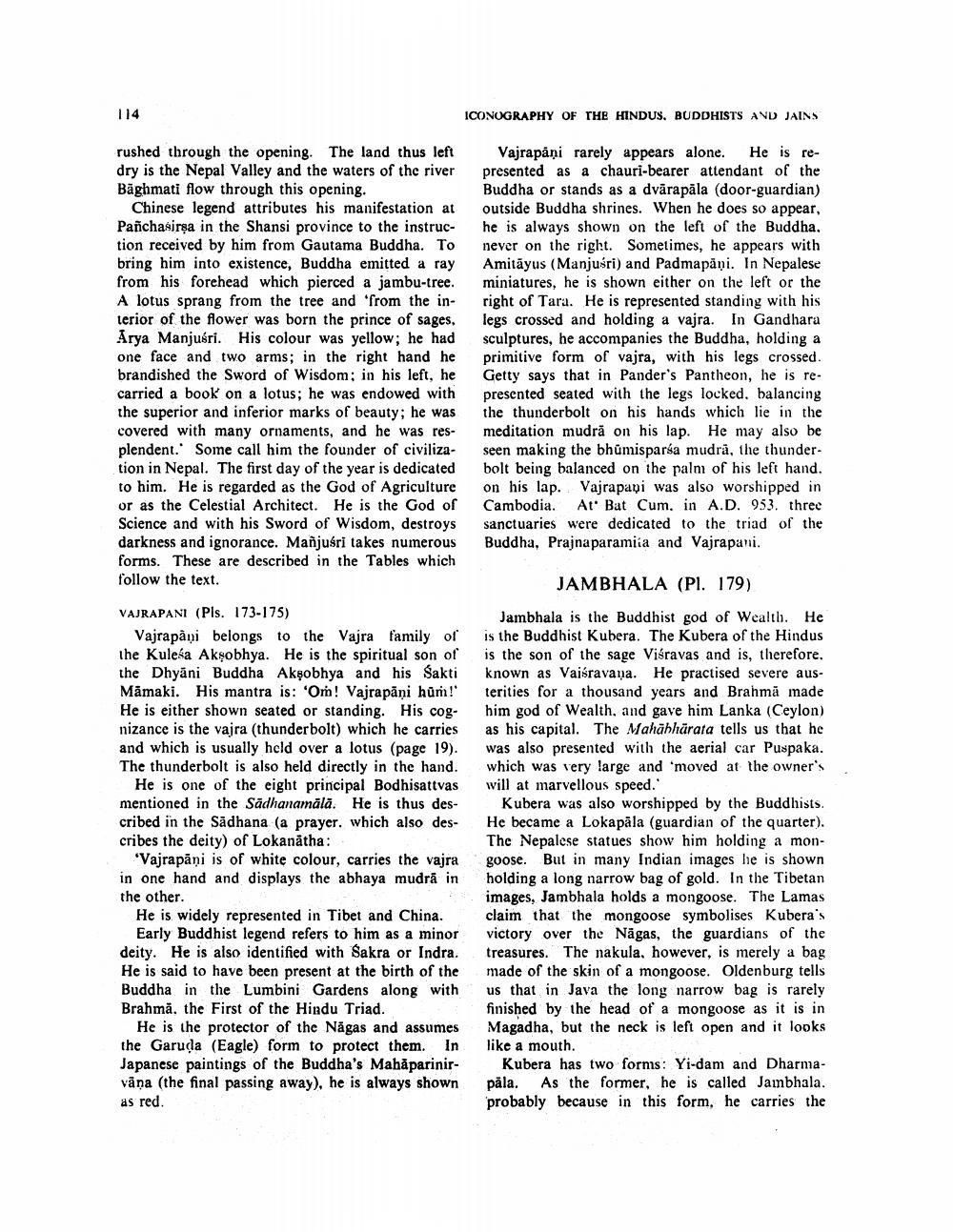________________
ICONOGRAPHY OF THE HINDUS, BUDDHISTS AND JAINS
Vajrapāņi rarely appears alone. He is represented as a chauri-bearer attendant of the Buddha or stands as a dvărapăla (door-guardian) outside Buddha shrines. When he does so appear, he is always shown on the left of the Buddha, never on the right. Sometimes, he appears with Amitāyus (Manjusri) and Padmapāņi. In Nepalese miniatures, he is shown either on the left or the right of Tara. He is represented standing with his legs crossed and holding a vajra. In Gandhara sculptures, he accompanies the Buddha, holding a primitive form of vajra, with his legs crossed. Getty says that in Pander's Pantheon, he is represented seated with the legs locked. balancing the thunderbolt on his hands which lie in the meditation mudrā on his lap. He may also be seen making the bhumisparsa mudra, the thunderbolt being balanced on the palm of his left hand. on his lap. Vajrapani was also worshipped in Cambodia. At Bat Cum, in A.D. 953. three sanctuaries were dedicated to the triad of the Buddha, Prajnaparamiia and Vajrapani.
JAMBHALA (Pl. 179)
rushed through the opening. The land thus left dry is the Nepal Valley and the waters of the river Baghmati flow through this opening.
Chinese legend attributes his manifestation at Panchasirsa in the Shansi province to the instruction received by him from Gautama Buddha. To bring him into existence, Buddha emitted a ray from his forehead which pierced a jambu-tree. A lotus sprang from the tree and from the in- terior of the flower was born the prince of sages, Arya Manjusri. His colour was yellow; he had one face and two arms; in the right hand he brandished the Sword of Wisdom; in his left, he carried a book on a lotus; he was endowed with the superior and inferior marks of beauty; he was covered with many ornaments, and he was resplendent. Some call him the founder of civilization in Nepal. The first day of the year is dedicated to him. He is regarded as the God of Agriculture or as the Celestial Architect. He is the God of Science and with his Sword of Wisdom, destroys darkness and ignorance. Manjusri takes numerous forms. These are described in the Tables which follow the text. VAJRAPANI (Pls. 173-175)
Vajrapāņi belongs to the Vajra family of the Kuleka Akşobhya. He is the spiritual son of the Dhyāni Buddha Akşobhya and his Sakti Māmaki. His mantra is: 'Or! Vajrapāni hūm! He is either shown seated or standing. His cognizance is the vajra (thunderbolt) which he carries and which is usually held over a lotus (page 19). The thunderbolt is also held directly in the hand.
He is one of the eight principal Bodhisattvas mentioned in the Sadhanamälä. He is thus described in the Sadhana (a prayer. which also describes the deity) of Lokanatha:
Vajrapāņi is of white colour, carries the vajra in one hand and displays the abhaya mudrā in the other.
He is widely represented in Tibet and China.
Early Buddhist legend refers to him as a minor deity. He is also identified with Sakra or Indra. He is said to have been present at the birth of the Buddha in the Lumbini Gardens along with Brahma, the First of the Hindu Triad.
He is the protector of the Nāgas and assumes the Garuda (Eagle) form to protect them. In Japanese paintings of the Buddha's Mahăparinir- vāna (the final passing away), he is always shown as red.
Jambhala is the Buddhist god of Wealth. He is the Buddhist Kubera. The Kubera of the Hindus is the son of the sage Viśravas and is, therefore, known as Vaiśravama. He practised severe austerities for a thousand years and Brahmă made him god of Wealth, and gave him Lanka (Ceylon) as his capital. The Mahābhārata tells us that he was also presented with the aerial car Puspaka. which was very large and 'moved at the owner's will at marvellous speed.'
Kubera was also worshipped by the Buddhists. He became a Lokapāla (guardian of the quarter). The Nepalese statues show him holding a mongoose. But in many Indian images he is shown holding a long narrow bag of gold. In the Tibetan images, Jambhala holds a mongoose. The Lamas claim that the mongoose symbolises Kubera's victory over the Nāgas, the guardians of the treasures. The nakula, however, is merely a bag made of the skin of a mongoose. Oldenburg tells us that in Java the long narrow bag is rarely finished by the head of a mongoose as it is in Magadha, but the neck is left open and it looks like a mouth.
Kubera has two forms: Yi-dam and Dharmapåla. As the former, he is called Jaibhala. probably because in this form, he carries the




